Table of Contents
eRISE Challenge 2011
The eRISE challenge 2011 was conducted for empirical evaluation of security engineering methods. The event was carried out in May 2011. Both parts of experiment, training and application phases, took place at Dauphine University, Paris, France.
You can look a video of eRISE 2011 presentation on YouTube and download slides. See the main page for our work on empirical validation of security risk assessment methods and other experiments.
Participants
In eRISE 2011 were involved the following participants: 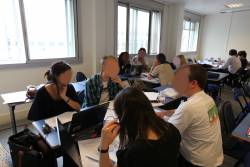
- Customers
- Yudistira Asnar (University of Trento)
- Federica Paci (University of Trento)
- Method Designers:
-
- 13 students were enrolled in the Master in Computer Science at the University of Trento;
- 36 professionals were attending a Master Course in Management of Information System Enterprise at Dauphine University. This master has an admission requirement of a minimum of five years of working experience in the field of Auditing in Information Systems
Evaluated Methods
The selection of the security requirements methods to be evaluated was driven by three main factors: the number of citations, the fact that research on the method is still ongoing, and availability of the methods designers.
Four methods have been evaluated and compared during eRISE 2011:
- CORAS is a model-driven method for risk analysis proposed by SINTEF, Norway. Materials: book chapter, tutorial.
Application scenario
In eRISE 2011 fictional application scenario, Healthcare Collaboration Network(HCN), was proposed to the participant for analysis.
Regional HealthCare Authority needs to monitor and alert citizens on occurrence of endemic or pandemic diseases within the region of CityVille. Healthcare Authority decides to create Healthcare Collaboration network involving data source organizations (like hospitals, physicians) and data review organizations (like government agencies, health insurers). Participants perform the role of consultants in analyzing the main threats; ensuring the information security and privacy protection of Healthcare collaboration network.
The participants, during the Training day, received two chapters of the HCN book (Ch.1 and Ch.6). Moreover the participants received a 1-hour seminar about HCN, which was given by one member of the organizing team.
The materials about this scenario are available online: HCN chapters, presentation, customer's email, Adverse Drug Event FAQ.
Experimental Procedure
eRISE 2011 was conducted in three main phases: 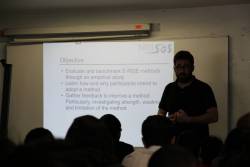
- Training Phase on May 13, 2011 (at Dauphine Paris University), where participants attended tutorials on the methods under evaluation and on the HCN case.
- Application Phases on May 14-27, 2011 (with face-to-face session on May 26-27 at Dauphine Paris University) where participants applied the methods to analyse security issues of the HCN case.
- Evaluation Phase, where participants evaluated the methods through focused group interviews while method designers evaluated the final reports.
 The goal is to assess the correctness of the methods application and the quality of the security requirements identified by the participants.
The goal is to assess the correctness of the methods application and the quality of the security requirements identified by the participants. - Two Post-it session were conducted for each method, each involving six participants, apart from one session, which had 7 participants. Each participant was asked to produce a total 20 post-its: 5 each one containing positive aspects about the method, 5 each one containing negative aspects about the method, 5 containing positive aspects about the competition, and 5 reporting negative aspects about the competition. All these post-it notes contributed to two Post-it clouds, one about the method and one about the competition, of 120 post-its per method (130 for one of the method), for a total of 490 notes.
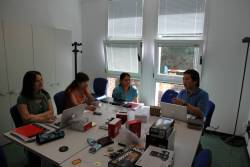
- Two focus group discussions were conducted for each method, each involving six participants, (apart from one discussion, which had 7 participants), the Method Designer and one member of the Organizing Team, which also served as moderator. Focus groups had a duration of 90 minutes each and yielded a total of 540 minutes of audio and video recordings.
Data Collection and Analysis
We have collected different kinds of data:
- Questionnaires include questions on subjects' knowledge of IT security, risk assessment, and requirements engineering and their evaluation of the methods' aspects. Questionnaires contained a combination of open questions and list of adjectives, rated by participants through 7-points Likert scales. The participants were administered four questionnaires during the execution of the eRISE 2011:
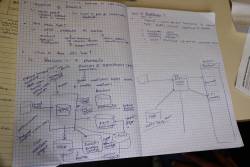
- Q1 was administered before the Training phase and aimed at collecting participant’s level of awareness on Information Security.(Q1).
- Q2 was administered to participants after the Training phase and aimed at collecting participants’ first impression about the method (Q2).
- Q3 was administered at the end of remote group collaboration and aimed at collecting participants’ opinion about the method when applied in a condition of remote group collaboration. This was also a mid-term overall evaluation of the method (Q3).
- Q4 was administered at the end of the Application phase, after the sessions of face-to-face group work sessions. This questionnaire aimed at collecting final evaluation by participants about the method (Q4).
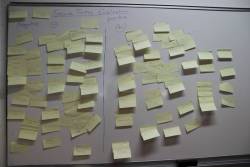
- Audio/Video Recordings* capture the application of the methods by subjects and the focus groups interviews;
- Post-it Notes* list positive and negative aspects about the methods and the study itself;
- Focus Group Transcripts* report the discussion with method designers a number of topics related to the method, its application on the given scenario and the process of evaluation.
- Group Presentations* by participants summarize the results of method's application;
- Final Reports* describe in detail how participants have identified the security requirements following the method.
* These materials are available upon e-mail request.
Data Analysis
Questionnaires have been analyzed using statistical analysis. For post-it notes we have used affinity analysis in order to group similar feedback on positive and negative aspects of the methods. The transcripts of the focus groups discussions have been analyzed using coding, a content analysis technique used in grounded theory. Coding helped us to discover text patterns that are relevant to what makes methods effective in identifying security requirements and why.
